THRASS: the phonics of Whole Language
35 Replies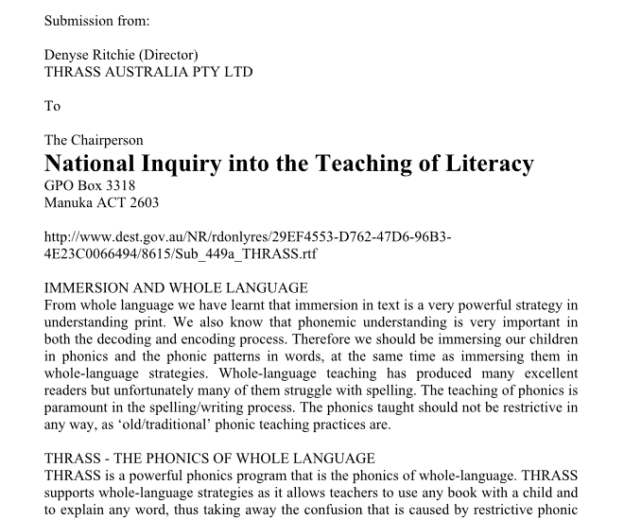
People often ask my opinion of the THRASS (Teaching Handwriting, Reading and Spelling Skills) approach, which has long been used in many Australian schools. Till now I’ve mostly replied that I’m no expert on it, but I’m yet to see robust research evidence supporting it, and aspects of it have never made enough sense to me to invest in the training.
I once worked at a school in a tiny room where lots of THRASS resources gathered dust. Two huge, laminated THRASS wall charts kept overwhelming their blu-tack and falling on my head.
I looked through the resources, but was working mostly with kids with language disorder or intellectual disability, and they would have been overwhelmed by wordy, THRASS-chart-based spelling explanations like this or this (cognitive load!). The THRASS graphemes kit was too big for our room’s tiny table, and lacked example words and some of the graphemes I wanted, so I made my own.
I tried using a THRASS board game but found it a bit incomprehensible. I don’t like teaching program-specific jargon, like “phoneme fists” or “grapheme catch-alls”, and rapping THRASS chart words might be fun, but I’m not sure why else you’d do it. (more…)
Half-price phonics playing cards, for social, screen-free fun
0 Replies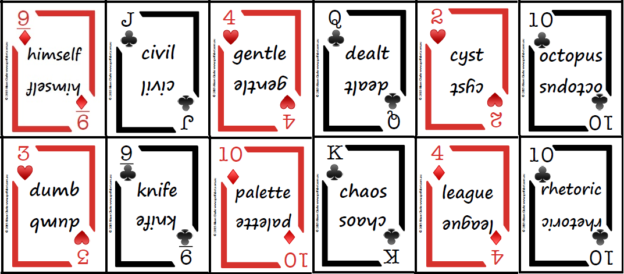
Before we had Netflix or even TV, families and friends had lots of fun together playing cards. Playing cards were invented in China over a thousand years ago, and spread via Persia and the Middle East to Europe by about 1400 (learn about their fascinating history here).
A standard deck of playing cards can be used to play hundreds of different games, involving matching, trick-taking, shedding, catching/collecting, fishing, comparing, and much more. From Snap to Poker, there’s something for every age and ability level.
Card games can be used for high-repetition phonics practice by putting words containing a student’s phonics targets on the cards, and requiring each card’s word to be read when it is played. I like to play a game, ask the student(s) to spell a few of the words on the cards, and then have another game. This reinforces the idea that reading and spelling are reciprocal processes.
If you don’t have favourite childhood card games you can teach kids, we have some videos of how to play games we like, and there are heaps more here, or just put “playing card games for kids” into a search engine to find a cornucopia of games.
12 new phonics playing card decks
We’ve just put a new set of downloadable phonics playing cards in the Spelfabet shop, These decks fill some gaps in our previous decks – compound words, “soft” C and G, additional spellings of “short” vowel sounds – and then present additional consonant sounds with multiple spellings. Here’s what one card from each deck looks like:
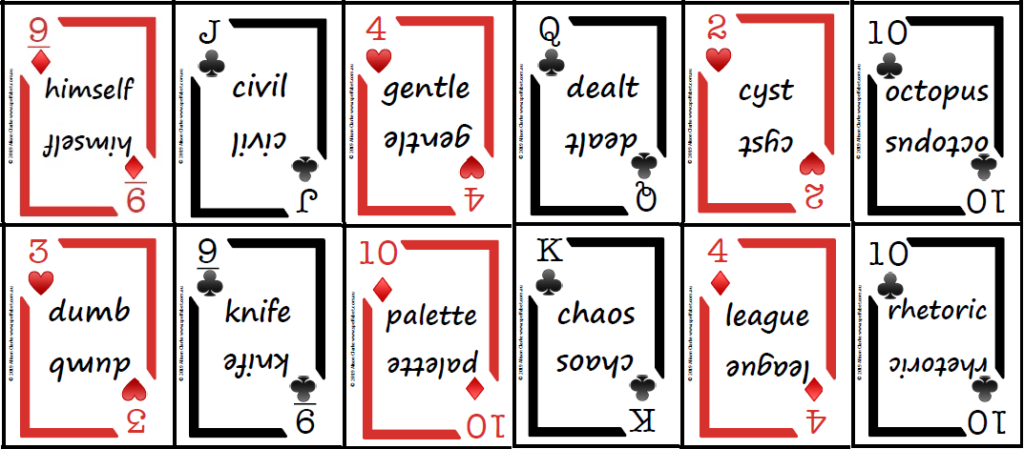
All our playing cards are half price till 13 September, the earliest date Melbourne’s COVID-19 Stage 4 lockdown will be lifted (fingers crossed, 179 new cases yesterday). Lots of us need fun things to do till then.
The cards are child-sized (5 X 6.5cm), with words facing in two directions, so they’re easy to read from either side of a table. Their sequence broadly matches the Sounds-Write/Dandelion/Phonic Books/Forward With Phonics teaching sequence, but if you use a different phonics teaching sequence, you can reorganise them.
Playing Cards Index page
There are now 81 decks of phonics playing cards in the Spelfabet shop (14 are free). It’s hard to scan through them all, so we now have a Playing Cards index page linked to the main menu, to help you find the deck(s) you want and get the best value for money.
The page is organised in groups based on how hard the words are, apart from the last group, which is a bit of a mixture. For each group, only two decks are showing until you change the “Show 2 entries” drop-down menu to say “Show 25 entries”, to make all the decks (between 12 and 18 of them) visible.
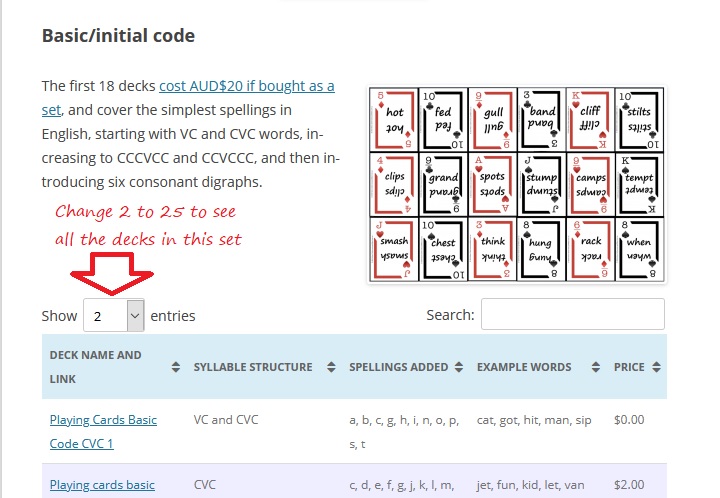
Download, print and cut up your cards, and enjoy!
These playing cards are downloadable files (that’s why they’re free/so cheap), so it’s your job to colour-print them on light cardboard (packs of 200gsm A4 cardboard are available at major stationers, some of whom will print them on card for you), laminate them if you plan to use them a lot, and cut them up, perhaps while watching Netflix/TV, or get the kids to do it. If any get lost or wrecked, you can just print more.
Thanks as always to the fabulous Spelfabet team for their work on these, especially Caitlin Stephenson for the original idea, Renee Vlahos for layout/formatting, laminating and lots of patient cutting-up, and Tessa Weadman for game video appearances, and lately for cheering us up with her new puppy at Zlunch.
Here’s the video of my LDA webinar on spelling logic
10 Replies
About 400 people had signed up to attend the webinar I presented for Learning Difficulties Australia on Wednesday called “English spelling has five kinds of logic”, but sadly, the LDA Zoom account locked all but 100 people out. I’m so sorry about that, I didn’t even realise till the end.
Anyway, here’s the video, so you can watch it at your leisure. Sorry I say “um” so much! Below the video is a list of some of the resources I’ve found useful for online therapy sessions targeting spelling, reading and related skills (including irregular verbs, which someone asked about), since I couldn’t fit as much practical stuff into the webinar as I had hoped.
If you have feedback or questions, or any great online teaching/therapy resource tips, please leave a comment.
Useful resources for online learning/therapy during COVID-19
- Decodable Readers Australia’s books are freely accessible online till 25th August.
- The Flyleaf Online portal, where all their books are currently free online, with homework.
- The ICT Games literacy activities.
- Phonic Books At Home minibooks and activity sheets, targeting vowel spellings.
- The Phonics Play Comics.
- Powerpoint games
- The Reading Elephant books.
- The Reading Magic and Spelling Magic apps I mentioned in the webinar.
- If you’re trained in Sounds-Write, try their interactive whiteboard activities, in Australia available from DSF for $95.
- WordWall, where lots of people have made activities you can use, or you can make your own if you subscribe. Ones we’ve made, including sets that align with the Sounds-Write and Phonic Books Catch-Up Readers teaching sequence are here.
Black Sheep Press has lots of downloadable speech and language activities, including on irregular past tense here and here. There are also apps like Past Tense with Splingo, and the Toddlers Seek & Find apps let you make something fun happen then discuss it. The ELR resources are another option for all kinds of online language activities.
Speech Pathologists needing articulation materials, try the Pottstown Schools website.
Good luck, stay well, and remember when life gives you lemons, you can make lemon tart, lemon curd, avgolemono, lemon butter, lemon delicious…(I’m not much into lemonade).
PS Don’t miss Emily Hanford’s latest, again-excellent report “What the words say”.
Is Reading Eggs all it’s cracked up to be? (boom tish)
22 Replies
After my last blog post about the new Reading Eggs – Fast Phonics program, its activity that looked exactly like a Nessy activity suddenly got new graphics. Then someone asked me why I’m not a fan of the original Reading Eggs program when it includes a lot of phonics, so I decided to take another look.
With hundreds of new COVID-19 cases daily (yeek) and a new face-masks-in-public rule, my state is heading back into another protracted period of home-based learning, probably including lots of e-learning. I want children to use programs that maximise their chances of successfully learning to read and spell.
Is Reading Eggs from the ABC?
I used to think that Reading Eggs was owned by the Australian Broadcasting Commission, because it uses the ABC logo.
Incorrect. Reading Eggs is owned by a company called Blake e-learning. It uses the trusted ABC name and logo in Australia under a retail partnership with ABC Commercial. The Reading Eggs site visible outside Australia, https://readingeggs.com, has no ABC logo (it quickly redirects Australians to the Australian site).
The ABC Commercial website says, “As an iconic, trusted brand, we are the only Australian distributor equipped to maximise the rights and opportunities across all product categories to help drive your business.” As a member of Friends of the ABC I was pretty surprised at that.
How should early reading and spelling be taught?
Beginning readers/spellers need be told from the very start that spoken words are made of sounds, which we write with letters. This seems obvious to literate adults, but is not at all obvious to young children, or many older learners. I once told a smart, illiterate teenager who’d had ten years of Australian schooling this fact, and he asked: “Why didn’t anyone tell me that?” (if you don’t know why, read journalist Emily Hanford’s reports or watch/listen to her recent PATTAN network talk here).
The sounds in our speech are invisible, quick and smoosh into each other, so splitting them up in order to spell them is hard. English is a mishmash of languages, warped over time (the wonderfully nerdy History of English podcast has details), so our writing system relates 44 speech sounds to 26 letters using five different types of logic:
- One sound can be written with one letter.
- One sound can be written with two, three or four letters e.g. sh, ou, dge, augh.
- Most sounds are written more than one way e.g. out, cow, drought.
- Some spellings represent more than one sound e.g. out, you, touch, cough, soul.
- Meaningful parts used to build longer words often have special spellings e.g. er, ed, ly, al, est, ous, chron.
Reading and spelling software for young beginners should stick to the simplest logic (#1). It should focus on teaching children to break up spoken words into sounds and write them with letters, and read words by saying a sound for each letter then blending the sounds together.
Like all good systematic, explicit, synthetic phonics programs (see examples) this software should start with just three to five sounds, represent them with single letters, and teach kids to use them to spell and read little words e.g. am, at, it, sat, sit, sis, mat and perhaps names like Sam, Sim, Tam and Tim.
Note that the words “is” and “as” don’t follow logic #1, as their last sound is /z/ (logic #4). Including them might confuse some children and undermine logic #1, so if they’re included they should be explained e.g. “at the end of words we often say /z/ for this letter”.
Extra sounds and their spellings should then be gradually, explicitly, systematically introduced and practised to mastery in short words (two or three sounds). Words can then be made longer e.g. with two consonants together as in “clip” and “tent”, then three as in “split” and “helps”, as consonant combinations can be quite hard to segment and blend.
This gives beginners a solid foundation for learning the additional sounds and remaining logic and patterns of our complex spelling system.
How does Reading Eggs stack up?
Reading Eggs offers a free trial period, so anyone can sign in and see the following things for themselves. It first introduces “the sound m, like in mouse” and presents the lower case letter m for children to click on to hear /m/ (I’ll put sounds in slash marks). There’s just letter m at first, and then children must discriminate it from two other letters. There’s no need to link sounds and letters in this activity, so it can be done using visual memory (not the kind of memory used in reading, see this blog post).
The program then asks “which picture starts with the /m/ sound?” and there are two pictures on screens e.g. “moss” and “sat”. I pretended to be a child without any awareness of sounds in words, and answered randomly. When I got it wrong, there was a “boing” sound with zigzags on the screens and I was told to “try again”. When I got it right, a cartoon character said a (less interesting) “yes”. No matter how many times I got it wrong, no help was offered. Eventually, thanks to having a 50-50 chance, I fluked it and went up to the next level.
I was then asked to “find /m/ in these words”, and printed words containing the letter “m” appeared the screen, but the words were not spoken, so again visual memory was all I needed. The words included digraphs (“moon”), split vowel digraphs (“time”) and two-syllable words (“metal”), examples of spelling logic #2 and #4.
When I clicked randomly I was told to “try again” till I eventually fluked enough correct answers. There was a song about words with “m” in them. The words flashed on screens with the letter m in a contrasting colour. To preliterate children, they probably look like chicken scratchings.
Next I was told to “complete the dot to dot to make the letter”, and there were numbered dots on the screen in roughly this layout:

I pretended I hadn’t learnt my numbers yet, and clicked randomly. I got three “boing” sounds and three red crosses on the screen, and then was asked “again?”. This happened no matter how many times I got it wrong. When I clicked on the dots in numerical order, the lower case letter “m” was filled in between the dots, and I was asked to do it faster. I hope a handwriting expert can tell us in the comments whether this sort of numbered-dot-clicking is a good way to teach early letter formation.
Next came a 6×6 letter grid with six copies of the letter “m” in it, in slightly different fonts, and including visually similar letters like “n”, “h” and “w”. I was told to click on /m/. When I made mistakes I got red crosses and “boing” sounds, and after three errors was asked “again?”, but the game did not adjust to my confusion by reducing the number of choices, providing hints or otherwise helping me.
I was then shown a letter “m” and told “This is the letter em, it makes the sound /m/’. Capital em looks like this (M), it also makes the sound /m/”. Preliterate me wondered why we have two letters for the same sound, but this wasn’t explained. A 6X6 grid like the previous one appeared, this time with capital letters, and again if I couldn’t find the M’s, the task was not simplified, I just went round and round being asked “again?” till I fluked it.
Next I was shown a letter “m” in a book and asked to click on the picture that begins with /m/. With only two pictures presented at a time, I had a 50-50 chance. The picture names were not spoken unless I clicked on the speakers next to them, and when I made three mistakes I had to go back to the start. There was no slowing down or stretching out of spoken words, or other explicit assistance with making the connection between the sound in words and the letter.
Next I was shown a screen arranged like this, and asked to drag the words to the pictures:
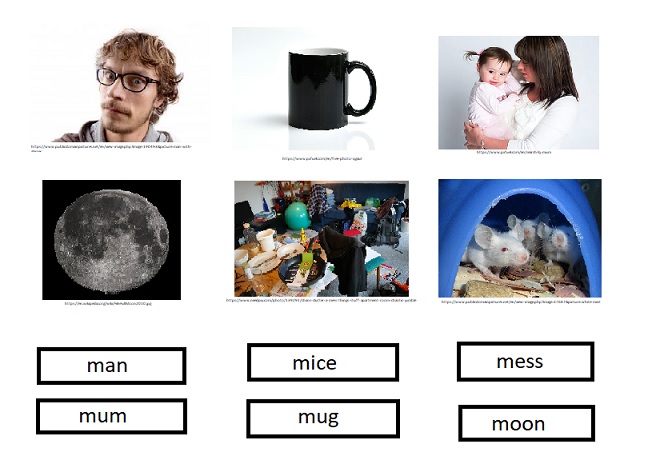
So far in this program kids have only learnt one letter, so can’t read the words, but that doesn’t matter because you just click on the words and they’re spoken, so all you need to do is match spoken words to pictures. You can just ignore the written words, and since reading them requires logic #2 (moon, mess, mice) and #3 (/s/ as in mess, mice), probably that’s a good thing.
Next there was a book with a different word starting with “m” on each page, including words with vowel and consonant digraphs, consonant blends and two syllables, and a total of 15 different sound-spelling relationships, some based on logic #2 (ey as in monkey and money, oo as in moon, ou and se as in mouse) and logic #4 (o as in money, monkey, mop; n as in man, monkey).
This type of book teaches preliterate kids to “read” by looking at first letters, pictures and guessing words. This is reading-like behaviour, but should never be confused with reading. So far only one sound has been taught, so kids aren’t yet equipped to start reading.
Next, the sound /s/ and letter “s” are introduced in much the same format. There is letter identification and matching, spoken word to picture matching (including the three-syllable word “spaghetti”), and a book about “s” with 23 different sound-spelling relationships involving logic #1, #2, #3 and #4.
In the third level I am invited to “Click on the word I” (my italics) and the capital letter “I” appears, first by itself and then with two other capital letters. Then I’m told I’ll be shown “the sound ‘am’ like in ‘clam'” (my italics). So this activity introduces two extra levels of word analysis – rimes (mislabeled sounds) and whole words. Preliterate me wondered why “I” is called a word, when it has only one letter, while “am” is called a sound, when it has two letters.
Next I was told to click on “am”, first by itself and then with distractor items like “xi” and “lu” on bowls of sugar cubes (Reading Eggs has also offered me cakes and marshmallows, so it’s not from the I Quit Sugar brigade).
Then I am asked to “click on the picture which has the am sound in it”, and pictures offered include “dam”, “ham” (which lots of people don’t eat), “lamb” and “stamp” (the latter being especially hard for little kids to discern the “am sound” in, as it’s not at the start or end of the word).
Then I’m shown the sentence “I am Sam” and asked to click on each word, after which the words are scrambled and I am asked to click on them again. Then I’m asked to “complete the dot to dot to make the letter”, though it doesn’t say which letter. It turns out to be a capital I. Preliterate me wonders why they’re now calling it a letter, not a word.

So far, Reading Eggs seems to be a mixture of initial, letter-of-the-week type phonics, picture-guessing and memorising whole words. In the next activity I’m asked to “say each sound and make the word” and shown how to blend “a” and “m” into “am”. This happens once only, and then I’m told “now it’s your turn”, and the visuals repeat, but not the sounds. The same thing happens for the word “Sam”. Then “a” and “s” (/s/) are blended to make “as” pronounced /az/. Nobody explains the sound change.
Next, lower case letter i is given its letter name (“I”), which you’ll recall was earlier taught as the “word” for upper case letter I. I’m asked to find six of them in a grid, but when I get to the grid I’m told to “click on /i/” (the “short” sound).
Sorry, but I really can’t justify spending any more of my time looking at a program that I am not going to recommend to anyone.
If you’d like my recommendations for early literacy iPad apps for little kids, see this blog post. Several of them have versions on other platforms, including Graphogame, Phonics Hero, Nessy and Reading Doctor.
Free download: My Reading and Word Journal
7 Replies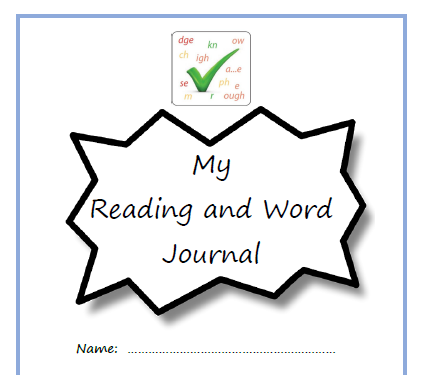
Here’s a free booklet for use in documenting early reading progress and giving credit where it’s due, now many parents with young children are home helping flatten the COVID-19 curve.
Download and print our new Spelfabet My Reading and Word Journal on A4 paper, fold and staple it, and use it to document children’s reading, in two vital categories:
1. Books your child reads. These should mainly contain the spelling patterns they’ve been taught (decodable books, there are quite a few free or heavily discounted ones available now). Reading such books builds word identification skills, which in turn build reading fluency.
2. Books you read aloud to your child. These might be stories, books about animals, places, the universe, anything that interests your child but is currently too hard for them to read themselves. This type of reading builds vocabulary and comprehension, and shows kids that reading is awesome. (more…)
Gin and phonics with John Walker
5 Replies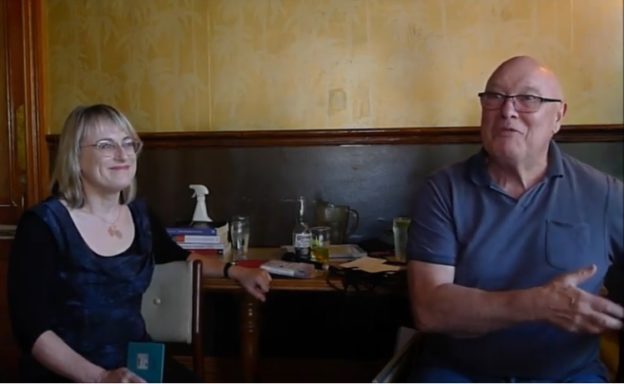
John Walker of Sounds-Write in the UK and I had a lovely time chatting about phonics at the pub last night. He is such an enthusiast for getting kids off to a great reading and writing start by helping them get words on and off the page quickly and automatically.
In the interests of flattening the COVID19 curve, most registrants for this free session watched online, not in person. I didn’t know Facebook Live was portrait format only, not landscape, so the Facebook video was sideways (oops, sorry). The other camera was right-way-up, so here’s its video, if you missed it and would like to watch.
INVESTed – amazing value conference in Gippsland
6 Replies
I’m madly reading up on phonological awareness so I can say interesting things about it at the InvestEd Inverloch conference on Saturday 29th February (an extra day, hooray for leap years). The full title of this conference is INVESTed: Sharing Best Practices, Supporting All Students, and it will be at the RACV Inverloch Resort by the beach in South Gippsland.
Like last year’s Sharing Best Practice conferences in Melbourne and Sydney, all the organisers and speakers are volunteers, to keep registration costs low at $88 concession/$99 full. A whole day of high-quality PD for under $100! TV advertisers would call it mad ape bonkers.
Here’s a summary of the agenda, more details are here:
- 8.30 Registrations
- 9.00 Welcome, Welcome To Country
- 9.10am Getting your school moving & improving through the power of instructional leadership with Stephen Dinham, Emeritus Professor, Melbourne University Graduate School of Education.
- 10.00am: Three options:
- Practical phonological awareness with me, Alison Clarke, mere Speech Pathologist.
- Decodable and predictable texts reflect theories about how to teach reading with Associate Professor Tanya Serry, who now (excitingly) works at the La Trobe University School of Education.
- Orton-Gillingham Math(s!) with Ron Yoshimoto, Orton Gillingham International Trainer.
- 11.10: Three options:
- Sharing what works: the common elements of evidence-informed instruction with Steven Capp, Principal of Bentleigh West PS.
- Better problem-solving with Catherine Scott, Psychologist, education academic and networker-organiser extraordinaire.
- Evidence-based mathematics instruction: from concrete to pictorial to abstract with Dave Morkunas, high-performance Teacher at Bentleigh West PS (watch him in action here).
- 12.00 noon: Three options:
- Changing practice, changing people: moving towards whole school structured literacy with Amanda Craig, Psychologist and Nellie Wilmot, Primary Teacher.
- Why spelling matters with Maureen Pollard of Little Learners Love Literacy.
- Cognitive Load Theory in Action with Oliver Lovell, Secondary Teacher, blogger and podcaster.
- 12.45pm: Delicious lunch.
- 1.15pm: Three options:
- Orton-Gillingham Literacy with Ron Yoshimoto, Orton Gillingham International Trainer.
- Overview of the highly effective Direct Instruction reading, language, phonemic awareness and spelling programs with Claire Scott, Teacher Trainer and Coach.
- Supporting students with working memory and processing speed difficulties with Kate Jacobs, Psychologist. Note that this will be a double session so…
- 2.05pm: Three options:
- Supporting students with working memory and processing speed difficulties with Kate Jacobs, Psychologist (continued).
- Writing: Can Balanced Literacy have impact? with Lyn Stone of Lifelong Literacy.
- Advocating for individuals with language and learning challenges: a parent and teacher perspective with Heidi Gregory of Dyslexia Victoria Support and Olivia Connelly of Gameplan and DVS.
- 2.50pm: Cognitive Load Theory and learning disorders: is there a connection? With Mandy Nayton, Psychologist, AUSPELD President and DSF WA CEO.
- 3:55 Thanks and close.
- 4.00pm Drinks and networking in the groovy-sounding Zenith Lounge.
I am absolutely kicking myself that I can’t stay for the afternoon, as my tiny primary school at the other end of the state is having its 150th celebrations that night.
Registrations for INVESTed close on 20th February, and if you’d like to make it part of a weekend at the beach, please book your accommodation soon, before it fills up. You might also like to stay on for two days of multisensory math(s) with Ron Yoshimoto. Ron will also be presenting courses on Orton Gillingham Basic in the week of 2-6 March and Orton-Gillingham Advanced (morphology) on Saturday 7th March (for which the Basic course is a prerequisite).
Finally, a huge THANKYOU and massive credit to Kerry Harvey, Catherine Scott and the other South Gippsland Learning Differences volunteer organisers.


